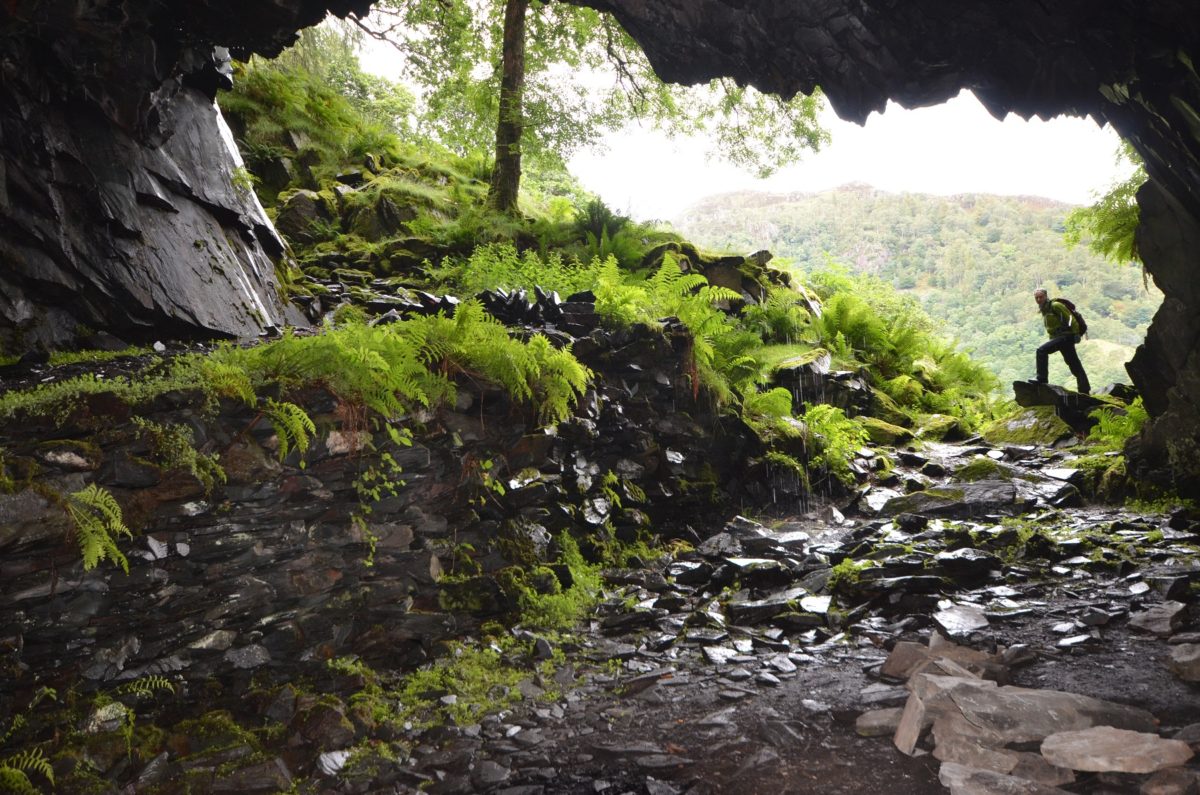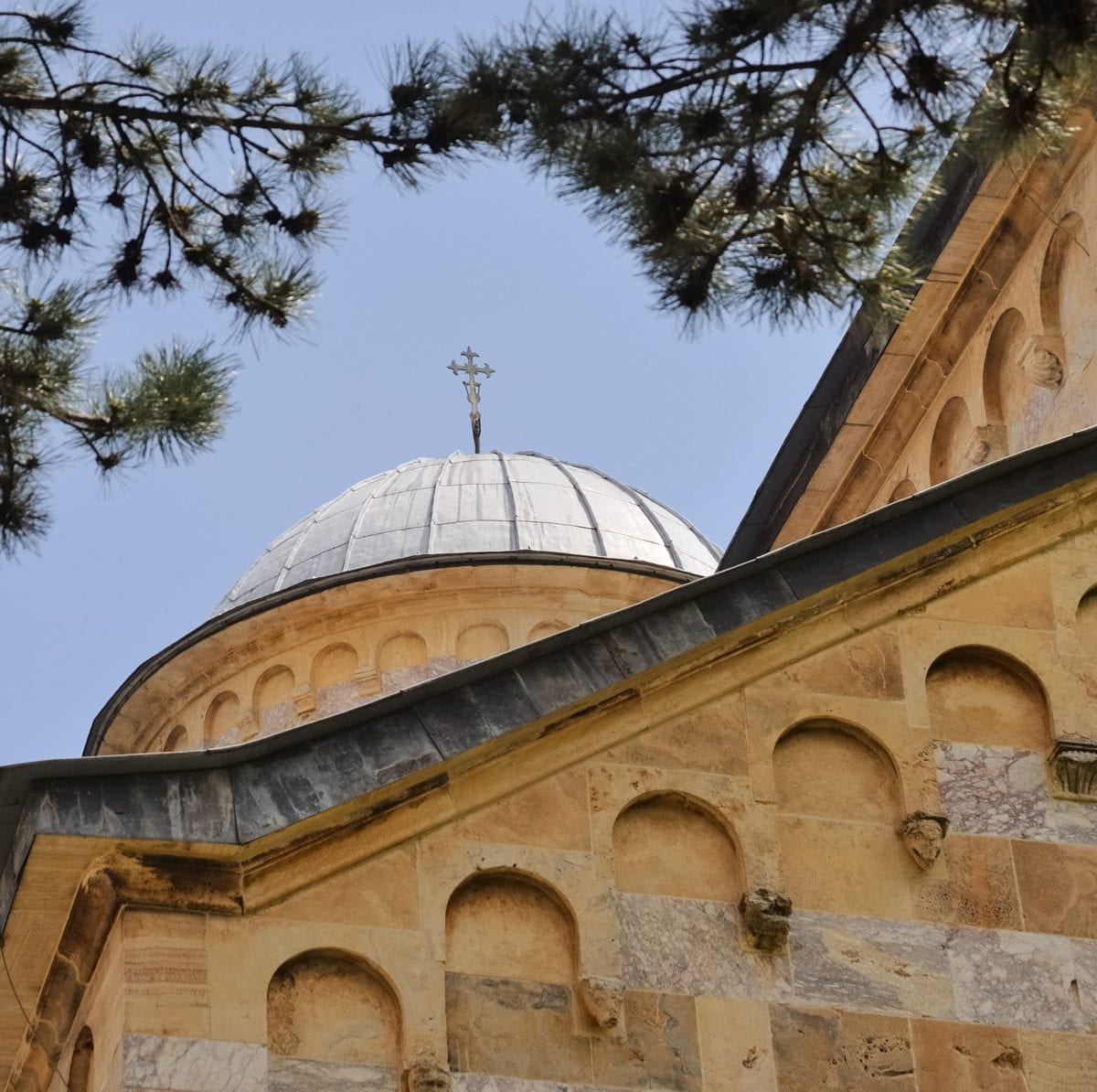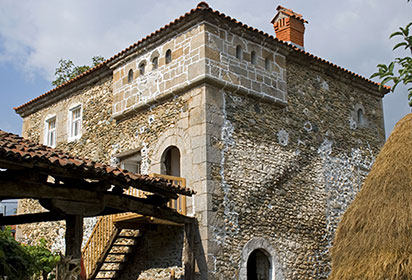Packed into a relatively small place, Kosovo has breathtakingly beautiful mountain peaks, waterfalls and wildflower meadows, fascinating cultural treasures, Ottoman-era buildings, stone houses, churches, mosques and medieval fresco paintings.
Verena Knaus and Gail Warrander authors of Kosovo: The Bradt Guide
Steeped in rich culture and history, Kosovo is a scenic and vibrant destination that remains relatively unexplored by tourists. Home to gorgeous monasteries at Visoki Dečani the Patriarchate in Peć and UNESCO-listed fortress in Novo Brdo, Kosovo is well-endowed when it comes to architecture, with preserved Ottoman-era buildings in beautiful Prizren and traditional stone kullas at Isniq or Dranoc.
For nature lovers or adventure seekers, the stunningly beautiful Rugova Valley offers fantastic walking trails toits lakes, waterfalls and mountain peaks and provides opportunities for hiking, mountain biking, skiing, paragliding and even zip lining.
The true charm of Kosovo, however, lies with of its people. When travelling in the country, you’re bound to be greeted by friendly, welcoming locals and first-class hospitality. Kosovar families take great pride in hosting guests so don’t be surprised to be invited into someone’s house for local delicacies such as tavas and raki.
Kosovo is fast-evolving; there are few visible traces of past conflict. What will be visible to those who visit is how the country’s history, culture, traditions and beauty all combine to make Kosovo a truly unique and intriguing travel destination.
For more inforamtion, check out our guide to Kosovo
Food and drink in Kosovo
Food
You will not be disappointed by the food in Kosovo. The choice and offerings of restaurants is truly outstanding and service is widely accepted by internationals and even locals visiting from Serbia and Albania to be the best in the region. The Kosovars really do take pride in and seem to enjoy serving you.
Albanian food is not widely known as a speciality but there are some truly delicious dishes. In particular try the tavë, or oven-pot dishes, which may include meat, tomatoes, aubergine or meat in yoghurt/egg sauce (the last is known as tavë elbasan).
Meat in Kosovo is generally good but try in particular the lamb (kingji) and veal (viqi) dishes. Veal escalopes are found almost everywhere, as is biftek, which is steak from the shoulder or loin. The kebabs are not usually served on a skewer but are put in a flat bread bap. Pleskavica, a Serbian word also used by Kosovo Albanians, is a larger flatter piece of minced beef which is grilled. Sometimes it is stuffed with cheese. Kosovo is also abundant in trout which are now also bred commercially. In the restaurants you will also find sea fish brought in from Albania.
Albanians and Serbs alike love peppers. Try the stuffed pepper dishes in the restaurants. Come September and the outlying streets and markets fill with vans with large packs of peppers of all colours and the odour of peppers fills the flats as Kosovo goes into industrious pepper-pickling mode for the winter. Autumn is also the best time to try the homemade ajvar, a pepper dip which is bottled for the winter.
In terms of cheeses try the Sharr cheese from Prizren and the Dragash cheeses. These are soft feta-type cheeses from cows and in the case of Dragash, sometimes sheep. The local yoghurt is also good. This is generally much runnier than the Bulgarian or Greek yoghurt, although also very tasty.
As a snack, or rather a meal in itself across the Balkans, burek is popular and most usually served in the morning as a breakfast or mid-morning snack. Burek is a sausage-shaped fried filo pastry filled most commonly with meat or soft white cheese and in some places with spinach. It is commonly served with white, unsweetened drinking yoghurt (ajran) in the pot or in a glass. Another pastry speciality, pita, is effectively a pie (although it can sometimes be sold as a sausage). The pie may contain meat, pumpkin, cabbage or root vegetables and even boiled nettles (hitha in Albanian). Out of all the pastry arrangements, the most typically Albanian is flija. This is traditionally cooked in a large broad covered pan over an open fire and consists of a tart made of pancake layers which are each added every 2 to 3 minutes one by one.
Kosovo is not strong on desserts. The restaurants will commonly serve a tiramisu. Local desserts tend to be extremely sweet, particularly baklava, which is sweet pastry deep fried and covered in syrup and the most commonly served. Baklava, which you may know from Turkey or Bosnia, is eaten at all times of the year but particularly after the Ramadan fast.
Drinks
Raki is a clear spirit made by all ethnic groups from fruit – the most popular being from grapes, pears, plums, or quince – and drunk at all times of the day (except by some devout Muslims) as a morning pick-me-up, aperitif, or after a meal. Slijvovica is the most common Serbian homebrew made from plums and is drunk in the same way as raki.
The most popular Kosovo beer is Peja beer which is available on tap (preferable) or in the bottle. Also popular is Prishtina beer and in 2012 the first craft brewery, Sabaja, arrived in Kosovo.
Coffee is an integral part of Balkan life. Over coffee, deals are done and politics, love and day-to-day life are discussed. In villages and homes you will be served Turkish coffee which is the grainy type (don’t gulp it!). You will be asked how strong you want it – mesme means ‘medium’. In the towns macchiato (espresso with foamed milk) is common, as is espresso or cappuccino (usually served with a very sweet chocolate sauce squirted on the top). Reflecting the Turkish influence, tea is also widely drunk in the home in Kosovo, more so than in Albania or Serbia and particularly in the Prizren area. The tea is served in Turkish-style small glasses on a silver or metal tray with much ceremony.
Health and safety in Kosovo
Health
At the time of writing, health insurance was not compulsory in Kosovo, although having such insurance is a good idea. Kosovo runs a health service subsidised by the general budget. This means that you do not pay for the medical staff themselves in the centres. You will, however, be expected to pay for X-rays, tests, bandages or medicines. Generally speaking these are not expensive. Receipts are issued on request. Most UK travel insurance policies will now cover Kosovo as it is no longer on the list of places prohibited by the UK Foreign Office, but do check the small print.
Travel clinics and health information
A full list of current travel clinic websites worldwide is available on ISTM. For other journey preparation information, consult NaTHNac (UK) or CDC (US). Information about various medications may be found on NetDoctor. All advice found online should be used in conjunction with expert advice received prior to or during travel.
Safety
Kosovo is very safe for internationals. While it always pays to take care of your belongings, street crime and petty theft in Kosovo are low and violent crime rates are much lower than in many Western cities. Most internationals, especially women, not only are very safe but also feel very safe in Kosovo, though should take the same precautions as elsewhere.
Kosovo is still a former conflict zone and demonstrations or violence occur sporadically. Usually such events can be foreseen and you should always avoid an area where a demonstration is announced (often there will be posters ahead of the event) or where a large crowd is gathering. Gun and knife ownership in Kosovo is still quite high so again it is strongly advised to keep away from any scuffle or argument, though in general, random acts of violence or robberies are rare. For the same reason be aware that it is still the Balkan culture to shoot into the air by way of celebration, including at weddings and on New Year’s Eve. There is also no control on the sale of fireworks and before New Year and Independence Day on 17 February Kosovo’s streets are flooded with stalls with cheap fireworks which would more than likely be banned or restricted elsewhere in Europe. These are all let off without any control or consideration. For this reason, it is best to take extreme care or, of course, you can safely watch the gunfire and fireworks from indoors or from a balcony.
While Kosovars may like to talk politics, there is a time and place for everything and it may not always be sensible to voice your views loudly in a heated situation.
If riots or unrest do develop in Kosovo, then it is possible that the mobile-phone networks will be shut down, as they were previously used in the March 2004 riots by the rioters to co-ordinate their activities. Shops will also close to avoid looting. While the likelihood of that happening is extremely low, it is worth bearing this in mind to ensure that you have enough food and an alternative means of contact or messages, eg: access to a land line or the internet.
All in all these risks are statistically incredibly rare, and overall more internationals are injured from car accidents or pot-holes. Many manhole covers are stolen for scrap metal and therefore open drains are a common hazard and are easily missed in daylight hours, let alone on a dark night. The story of the international who fell down a hole is all too common.
Kosovo police (KP)
The KP is generally regarded as one of the success stories of the new state. They are not perceived to be very corrupt and are generally helpful and friendly. Having said this, from a Western perspective you may find any visit to the police confusing and rather bureaucratic with many pieces of paperwork with puzzling purposes, and it may be best to take or arrange for your own interpreter if your visit is planned. If you come into contact with the police, as with anywhere the key is to show respect and co-operation and this will get you a long way.
LGBTQ+ travellers
Although changing slowly, Kosovo remains a conservative society and homosexuality/lesbianism is not openly discussed or demonstrated and is still regarded as taboo. This is not to say that there are not clubs or meeting places and there is a definite underground scene, particularly in Prishtina, Peja and Gjakova. More than anything you should be aware that while it may be fine for internationals to ‘come out’, this is not yet a feasible option for many Kosovars where the family pressure is strong. Exposing the clubs or bars just now may harm them rather than help them.
Like parts of the Middle East and Turkey, you may see men walking arm in arm. This is a sign of friendship rather than homosexuality so be careful of the consequences of misinterpreting it.
Children in Kosovo
Kosovars simply adore children and the streets are full of them playing on their own outdoors. Taking your child to a restaurant is not taboo. There are several international kindergartens and an English- or German-speaking dedicated nanny working from 09.00 to 17.00 only costs around €300 a month. You will almost never have to worry about finding a babysitter as your landlord or colleague will magic one up from somewhere. There are now plenty of shops selling nappies and good baby-food brands (including baby milk), buggies, car seats and other baby gadgets.
Travel and visas in Kosovo
Visas
Citizens from EU countries, the US, Japan, Canada, Australia and New Zealand citizens as well as EU candidate or neighbouring countries are not required to possess a visa to enter Kosovo. Most of those from a third country, eg: India, who possess a valid Schengen visa are also permitted entry. Those from countries regarded as high risk for illegal immigration, eg: parts of Africa and Asia, already face entry problems in the region and may be turned back. After legal entry visitors can stay for 90 days. If you stay longer than that, you must register with the police. If you are staying for medium- to long-term business, consultancy or similar, then it is worthwhile getting a temporary Kosovo resident’s card/permit which will facilitate all manner of business and avoid the need for Kosovo stamps in your passport.
Serbian stamp
At the time of writing and possibly for the foreseeable future, Serbia does not recognise the internationally managed borders of Kosovo. Therefore in the eyes of the Serbian authorities, if you enter Kosovo directly via Macedonia or Albania or Prishtina Airport, then you have entered illegally. This means that you cannot then later cross into Serbia from the north of Kosovo or even from Montenegro as the border guards will note that you do not have a valid Serbian entry stamp in your passport. If therefore you wish to enter Serbia, you must go out into Macedonia or Montenegro and enter Serbia. If you flew into Belgrade or entered via a ‘legitimate’ Serbian border, eg: the Hungarian or Croatian borders, then you are OK in the eyes of Serbia, so long as you do not then cancel out your entry stamp by going out through either Macedonia, Montenegro or Albania. This political problem has given rise to what the internationals term ‘a stamp run’. A stamp run is a trip that you do specifically to get a Serbian entry stamp. It usually involves going to Skopje and then on to Kumanovo, into Serbia and back into Kosovo via Bujanova in Serbia and across the border into Gjilan.
Getting there and away
By air
Prishtina International Airport is well served by scheduled flights and handles almost two million passengers each year, primarily diaspora and internationals. There are almost daily flights to Istanbul on Turkish Airlines; five to seven (depending on the time of year) on Austrian Airlines to Vienna; almost daily flights to Ljubljana with Adria Airways and starting in June 2017, two flights a week on Wizz Air from London Luton. Croatian Airlines operates flights to Zagreb several times a week. Adria also provides a good connecting route to other destinations such as London or parts of Scandinavia.
Skopje Airport in Macedonia is about 1 hour 40 minutes’ drive from Prishtina, and so is the best alternative and offers direct flights – particularly low-cost – to many cities throughout Europe.
By car
You can drive your car into/through Kosovo with no problem and it is very common to see foreign cars in Kosovo. The Green Card insurance is, however, not valid in Kosovo so that foreign registered cars (other than those with Albanian or Macedonian plates – countries with whom Kosovo has an agreement and sometimes Serbian plates) must pay €15 at the border for a 15-day third-party liability insurance policy. Note that if you intend to hire a car in Bulgaria, Bosnia & Herzegovina, Croatia or Montenegro, etc, you need to check that the car-hire company will let you take it to Kosovo.
Warning! Though the situation has improved, it is not advisable to drive a car with Serbian number plates, particularly Belgrade plates, around Kosovo generally, even though you may see such plates in Serbian areas.
By train
It is now possible to get to Kosovo by train, but this is a slow route and trains are infrequent and less reliable than buses. The trains do cross directly from Kraljevo/Raška in the north, ie: from Belgrade to North Mitrovica twice a day and from there you will have to catch a bus or a taxi to the Ibar to continue your journey south, so in many ways it may be much quicker and less of a hassle to get a bus directly from Serbia if you are short on time. The trains also connect into the south of Kosovo from Skopje. There are sleeper trains to/from Athens, Thessaloniki and Skopje. While considerably slower than the bus, the route from Skopje to Kacanik runs through a gorge along the river, is incredibly scenic and so worth the journey if you have plenty of time.
By bus
This is the cheapest way of getting to Kosovo and there are a lot of international buses from as far afield as Sweden, and in particular, plenty from Germany. The number goes up in the summer.
Getting around
By car and rental car
If you do not have your own car, it is possible to rent one in Kosovo. There are several international franchises and also some independent chains. Prices are now dropping, making the exercise more reasonable (they are now from €20 per day for a small car, to €75 for a 4×4). Driving around Kosovo is like driving around much of the Balkans. Be prepared for anything and in particular for reversing the wrong way up a street and for some aggressive overtaking. Roads in Kosovo are of mixed quality. Be prepared for pot-holes or breaks in the asphalt, even on the main roads where construction seems to be never-ending. They come as a standard feature on the side roads. In an effort to humorously highlight the problem, Koha Ditore, a local newspaper, once ran a competition for the biggest pothole in Prishtina that it would name after the city’s mayor. There were dozens of entries but the winner was a hole which was more than 50cm deep and several metres long. For now, it’s safe to say Kosovo has some of the best highways to drive around in the Balkans with, at the time of writing, a brand-new one to Skopje just about complete.
By taxi
Given the high cost of renting a car, getting around by taxi can be a viable option. Trips within towns typically cost €2–4. For longer trips you can choose either to do the journey on the meter or negotiate a price; the latter is preferable if you wish to stop to take photos.
By bus
Buses in Kosovo are frequent, quite fast, reliable and reasonably priced and they cover most of the country. The only time you will struggle with connections is between Kosovo Serb and Kosovo Albanian areas, eg: buses to Štrpce are not frequent. The buses are heavily used by Kosovars and are a very feasible way of getting around. The drivers are welcoming and patient with foreigners. Even though they themselves may know little English (try German), they will find someone who does, such as another passenger. Generally the bus will also stop on request if your destination is halfway along the route, eg: Mirusha or the Gadime Cave turn-off.
By train
The use of trains within Kosovo is only really a viable option if you wish to go a reasonable distance, eg: Prishtina to Peja, or Prishtina to Skopje, and/or you are lucky enough that the time suits you. Otherwise, even if/when the north–south line restarts (it is currently suspended), trains are generally slow and infrequent. Ticket prices within Kosovo are zone-based and never more than €3.00 – usually more like €0.50. Trains are, nevertheless, warm and comfortable, if not deluxe.
By bicycle
It is possible to cycle around Kosovo but the main roads are not ideal due to a combination of drivers unused to cyclists and pot-holes. Kosovo is, however, ideal for mountain biking on the side roads, or off-road.
When to visit Kosovo
The best time to come to Kosovo is spring (ie: late April, May or early June), when the fields are bright green but there is still some snow on the tops of the mountains and the flowers in the meadows are in bloom. There is a risk of heavy rain in late April but it is rare for this to last more than a day or so. In July, August and early September the flights and roads are busy with the diaspora returning, so travelling is not quite as easy or cheap and the weather can be too hot to explore, although September generally offers pleasant weather. In the winter there is a risk of ice and fog on the roads and in practice it will be difficult to see much due to the snow.
Climate
Kosovo has a continental climate, with hot summers and cold winters. Snow can fall as early as November and as late as April. July and August are invariably hot, although May and June can be too. The night-time/daytime temperature differential is generally greatest in September and October.
The average daytime temperature in January is –0.9°C and can reach –15°C on a bad night, while the average daytime temperature in July is 21.5°C but temperatures can go as high as 35°C. Temperatures differ little across Kosovo – just a couple of degrees – though there is often a noticeable difference when crossing into Macedonia or Albania to the south. In autumn, the average monthly rainfall is 177mm, whilst in summer it is 129mm. Rainstorms can be heavy and, due to an absence of storm drains and poorly designed roads, streets can quickly turn into floodstreams. From December to February, there is often very heavy fog in the major cities from increased coal burning; prepare to have flights cancelled during this period, as it is difficult to land at Prishtina Airport in these conditions.
What to see and do in Kosovo
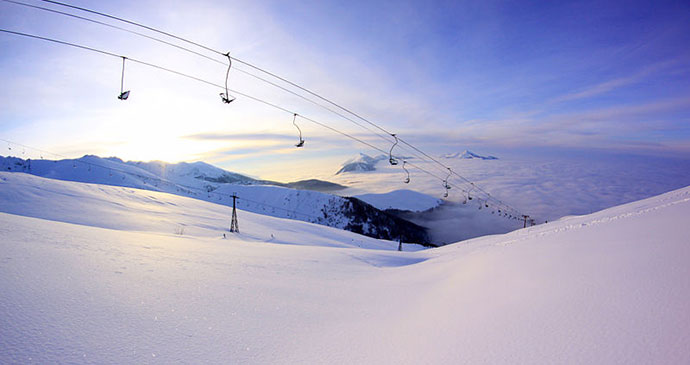
Brezovica Ski Centre
To ski in Brezovica you have to adjust your expectations as Brezovica really is like no other ski resort. Despite being a Serb area, lots of Albanians visit. Many do not have an interest in skiing, so they just come on a day trip, often scantily clad or in jeans, just to slide around the snow, take photos and hang around the restaurants. For them this is a special trip and they certainly seem to have a great day out.
A manager of a Western ski resort might suffer a heart attack at the absence of safety arrangements as the crowds congregate right on the pistes intermingled with sleds and teenagers shooting down the slope out of control on pieces of plastic. Furthermore, as if to create a target for the sledders and skiers rather like a skittle alley, the local vendors set up stalls of food, drink and beer right at the bottom of the piste next to the chairlifts. The operating slopes include one beginners’ slope and one steep black/red run on the front of the double chair and a red on the backside. The pistes are neither marked, nor groomed. For all these reasons and the absence of snow patrols, helmets are a good idea and while there is great off-piste skiing to be had, small avalanches are not unheard of. Go with a friend and bear in mind that there is no real rescue service and limited health care. The lifts have to be switched to the generators if the power stops so don’t rule out being suspended in mid air for short periods and wear appropriate clothes.
Prices are cheap, with day ski passes only €6. Weekend passes are also available. Beginners’ and towbar lift passes can be bought for €1, and if you are a pedestrian but just want to ride the chairlift, it costs €2 for a round trip. To hire skis or board and boots costs €5–10 per day. There is a good choice of kit (both good-quality skis and snowboards) at several outlets (you must leave ID).
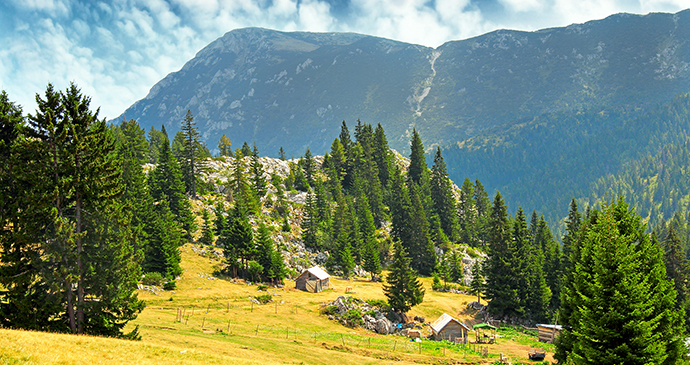
Mokra Gora Mountain, part of the Rogozna range, stands near Gazivoda Lake © Pecold, Shutterstock
Gazivoda Lake and Mokra Gora
Gazivoda is Kosovo’s largest and most beautiful lake. The manmade lake was built in 1977 as part of the Ibar-Lepenc hydro system supplying irrigation and drinking water to north and central Kosovo. Formed by one of the largest earthen dams in Europe, the lake also extends over the border into Serbia. Its panoramic setting amidst the Rogozna Mountains makes it one of Kosovo’s most striking natural attractions. The lake stretches over a length of 24km and offers great swimming, walking and mountain-biking opportunities. There are several little beaches along Gazivoda; just park your car at road level and walk down. There is also a peaceful beach further down between Tušiće and Dragalice, where you can bring your own picnic for a pleasant afternoon.
Mokra Gora Mountain is part of the Rogozna range. Its main attraction is the via ferrata, which snakes its way to the top of the 1,731m-high Berim Peak.
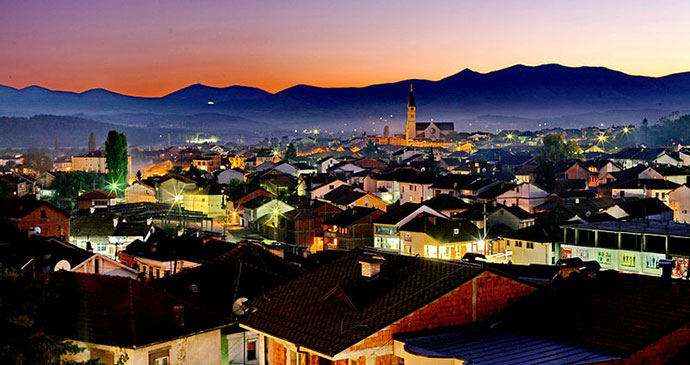
Explore Gjakova’s restored market, mosque and bridges © ShkelzenRexh, Wikimedia Commons
Gjakova
Gjakova lies almost equidistant between Prizren and Peja. Although many internationals never make it to Gjakova, it is really worth visiting for a half or full day, in particular because of the old restored market, mosque, Ethnographic Museum, madrasa, bridges and its history. There are also some of the best restaurants in Kosovo (it is particularly well known for its seasoned meat and lamb dishes) and has a much better-priced hotel selection than Prizren. Furthermore, it is second to Prishtina in terms of nightlife and famous for its traditional music. This means that if you are touring Kosovo there is a lot to be said for heading to Gjakova from Prishtina and using it as a base for one or two nights while visiting Peja, Isniq, Deçan, Prizren and the outlying villages, rather than switching hotels between cities. While you can wander round Gjakova on your own, like in Peja it may well be less frustrating and a better use of your time to pre-arrange a tour for the little extra it costs.
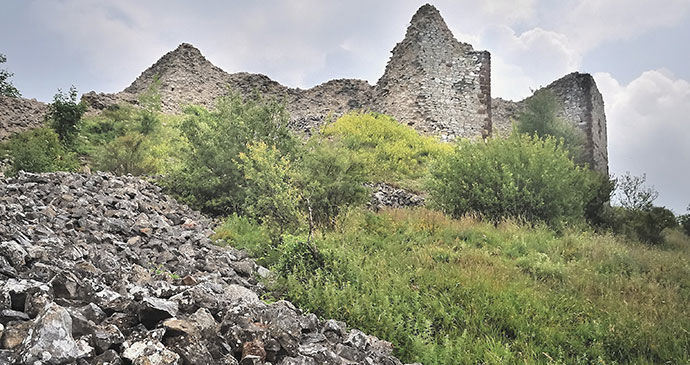
The Novo Brdo Fortress is set to become Kosovo’s fourth UNESCO World Heritage Site © Ivan S Abrams
Novo Brdo Fortress
Since excavation began in 2014, it has become increasingly clear why the Novo Brdo fortress will eventually become Kosovo’s fourth UNESCO World Heritage Site. You can access the site by driving the winding path around the back, or park at the bottom of the hill for a heart-pounding walk up. There are two clear rings of walls indicating the upper and lower cities. At the time of writing, the lower city is still being excavated and rebuilt, but the upper city can be visited by contacting the rural tourism NGO for a tour with a local expert. Inside the walls of the upper city you can see several distinct structures, unearthed during excavations, including: a hammam; a church (used for storage by the Ottomans); two water reservoirs; an oven used for melting metal; and six defensive towers (one of which has stairs to the top for breathtaking views out over the countryside).
At the foot of the fortress is the 18th-century Osman Effendi Mosque, which is noteworthy for the fact that the incomplete stone minaret is separated from the main building. This is because the current mosque – rebuilt after being badly damaged during World War I – is smaller than the original and the existing minaret remained unfinished. Near the mosque can be found the remains of St Nicholas Church, thought to have been built as early as the 12th century. The church was converted to a mosque in 1466 and it is still possible to see the foundation of the minaret adjoining the church wall. It was renovated in the 1950s. Across the street is the Turkish türbe, or mausoleum, built during Ottoman rule.
On a hill opposite the fortress, it is also possible to see the foundation of the 14th century St Mary Church, built by the Saxons. It is across from what is believed to be a Turkish cemetery, where local scavengers have come for centuries in search of jars of gold thought to have been dropped or buried here during the height of the mines. There are believed to be more than 900 graves in the proximity of the fortress. A Jewish graveyard can be seen on the left as you approach the fortress from Mejdan.
While official tours of the mine complex do not yet exist, it is worthwhile to walk or drive through this eerily quiet part of town. You can see the remnants of the original elevators and cable car, passing the Polish mine (operational 1984–89) on your way back around towards Bostan. The Bostan church (known as the Church of Shndërrimi or the Church of the Transfiguration), which dates from 1868, also merits a visit. Turn down the road opposite the municipality building. The key is kept by the Roma caretaker at the house within the walls. There are some simple frescoes. A much older church, which is thought to date from the 6th century, is now only ruins higher up on the other side of the road to the municipality.
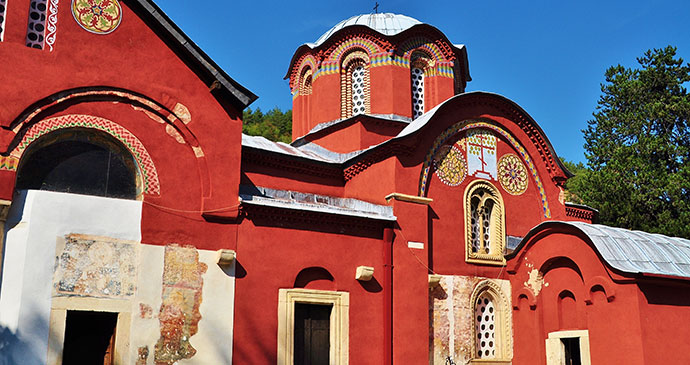
The monastic complex of Peć © o.jay photography, Shutterstock
Peć Patriarchate
Peć (Peja) is seen as the spiritual seat of the Serbian nation and the mausoleum of the Serbian archbishops and patriarchs. The monastic complex is surrounded by high stone walls protecting it from sight and against the elevated road leading into the Rugova Gorge. Set in this beautiful mountain scenery, with the sound of the Bistrica River in the background, it is easy to imagine why Serbian archbishops and patriarchs wanted to have their final resting place here. Only the occasional rumbling of a car winding up the Rugova road disturbs the peaceful atmosphere. There is parking just outside the monastic complex. The entrance is through a tall gate: to your left are the monastic living quarters and to the right you see the three-chapel construction of the Patriarchate.
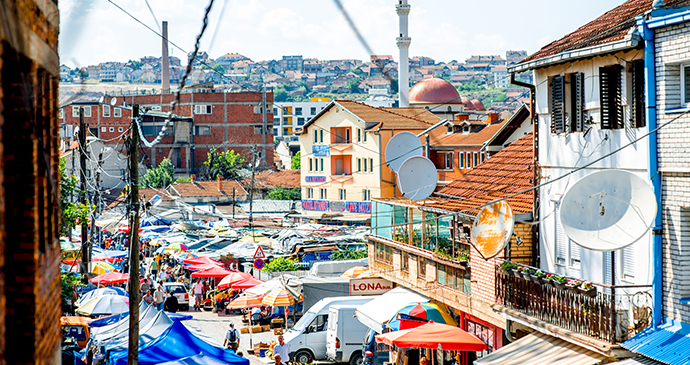
Prishtina
Prishtina is not a city you fall in love with at first sight. It is messy, with centuries-old Ottoman heritage competing with communist designs and recently built architectural monstrosities. This humble-jumble of new and old, Ottoman and communist, innovative and traditional, gives Prishtina a unique urban feel. A century ago, Prishtina was a multi-cultural and vibrant trading town with a colourful bazaar at its centre and a population conversing fluently in Albanian, Turkish and Serbian. Mosques, Catholic and Orthodox churches adorned the city’s skyline and a small Jewish community ran its own schools. The forceful transformation from an Ottoman trading town to a communist capital, from Yugoslav socialism to parallel Albanian self-rule and from Milošević to UNMIK rule has left many marks of destruction. Only now, as capital city of an independent state, is Prishtina starting to reassert a new urban identity.
Prishtina has always been a city in flux, with people coming and going. In different waves of migration Prishtina lost its Turkish-speaking urban elite, its Jewish and more recently its Serbian population. The arrival of thousands of international administrators, policemen, NATO soldiers and NGO activists from all corners of the world since 1999 has added a cosmopolitan flavour to the town. The city’s sudden exposure to the outside has made it open for change, new cuisine and different ways of life. Today, Mexican, Nepalese and Japanese restaurants are vying for customers alongside the old qebaptore (kebab shops) and smoke-filled kafe qajtores (tea houses).
Prishtina is certainly no beauty, but there are many well-hidden secrets. The best thing about the city is the people you meet. A closer look with an open mind makes Prishtina a good place to explore and a fun place to live in.
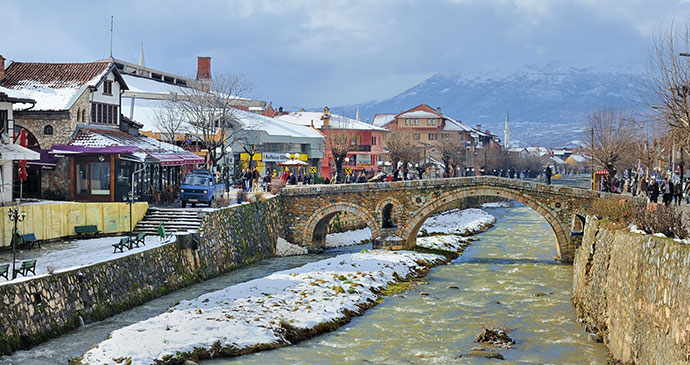
Prizren has been labelled Kosovo’s prettiest city © Ivan S Abrams
Prizren
This is the jewel in the crown of Kosovo and a ‘must-see’ for any visitor. It has the highest number of preserved Ottoman buildings with their upper storeys jutting out into the narrow cobbled streets. Prizren has not only retained the architecture from the Ottoman era but also many other flavours of Turkey, with the language being widely used, and delicious Turkish food.
The town is close to the Albanian border, with mountains on two sides. It has good access to water, with the Bistrica/Lumbardhi River flowing fast through the town and a pleasant sheltered climate. From the castle/kalaja you get a fabulous view of Prizren and out to Pashtrik Mountain and Albania on one side, and if you make your way to the back of the castle there are also views towards Prevalac Mountain and the Lumbardhi River and Zhupa Valley, with the old, Dušangrad upper castle along the riverside about 3km away. The castle is currently undergoing a three-year, US$700,000 preservation project funded by the US embassy. Extensive restoration works are ongoing, with the future possibility of it becoming a managed, self-sustaining tourist attraction.
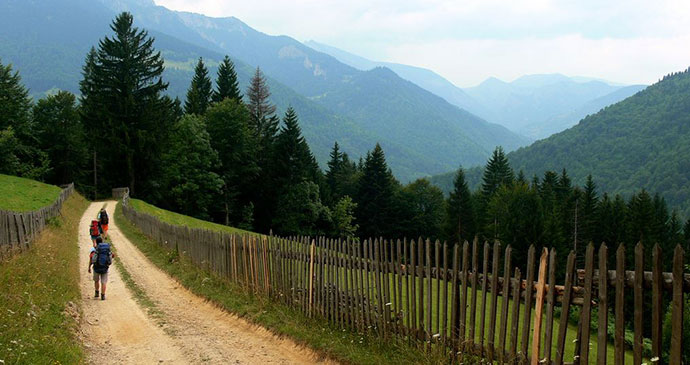
The Rugova Valley is home to lakes, waterfalls and hiking trails © Daniel Sevcik
Rugova Valley
The Rugova Valley is stunningly beautiful in all seasons and provides a wealth of sporting opportunities that are largely unexplored. With peaks of the Accursed Mountains (or Bjeshkët e Nemuna) rising up to 2,560m at Marjashi Peak, there is great potential for skiing, snowshoeing, paragliding, rock climbing and caving. Wonderful hiking opportunities abound (including crossborder), and in recent years, a lot of work has been done on marking trails along the Peaks of the Balkans and Via Dinarica, though it’s still probably best to hire a guide to get the most out of your experience.
The Rugova region covers an area of 32,000ha, encompassing 13 villages at different altitudes between 1,000m and 2,000m above sea level. Far out of reach of the towns, these villages had always enjoyed a special tax status during the Ottoman era in return for maintaining the mountain roads. The narrow gorge along the Bistrica River continues for about 12km from the Patriarchate, then the valley opens up into beautiful mountain scenery stretching all the way to Montenegro. There are 30m-high waterfalls and two lakes at about 1,800m above sea level, and numerous, undiscovered caves dotted around the mountains. A few years ago, a via ferrata course was opened near the entrance of the gorge and then in 2016, the longest zip line in the Balkans was installed just across the way making Rugova a true hotspot for all levels of adventure seekers.
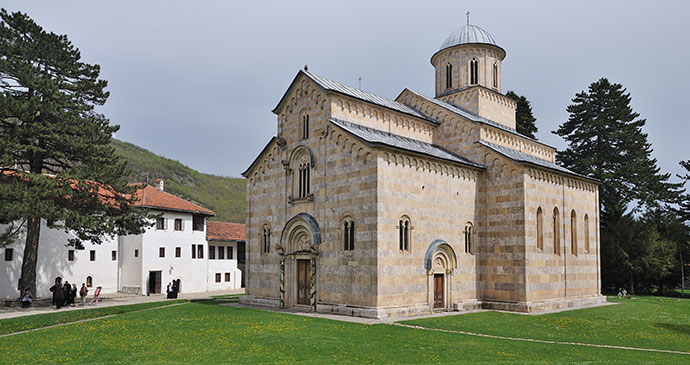
Visoki Dečani Monastery
The undisputed highlight and a real must for any visitor to Kosovo is the magnificent Visoki Dečani Monastery, set in the beautiful surrounds of the Deçan Canyon. The monastery is about 2km from Deçan Town, easily accessible by road. KFOR troops guarding the building will ask you for an ID card. A special highlight is the weekly evensong on Thursdays at 19.00 and the choral church service on Sundays at 08.00. If you can time your visit, it’s an unforgettable experience to listen to traditional Orthodox chorals in this amazing setting.
A wall surrounds the monastery and as you enter the complex through an impressive gate, a spectacular view opens up in front of you. The church walls are built with carefully hewn blocks of red-purple and light-yellow marble, set against a beautifully composed monastic complex. Take a moment to enjoy this peaceful setting before entering the church itself and make sure to visit to the monastery gift shop just over to the right on your way out.
Rahovec is one of the epicentres of Kosovo’s wine industry © Bujar Gashi, Wikimedia Commons
Wine Country
Throughout southern Kosovo you will find red ‘Wine Routes/Rruget e Veres’ signs scattered around the region. The creation of the routes was a European Union project implemented several years ago with good intentions, though how functional they have actually turned out to be is debatable.
Velika Hoča is a Serbian village with estimates of up to 700 inhabitants about 8km from Rahovec in the direction of Suha Rekë. It includes a cluster of very historical buildings and has its own atmosphere and pace which is quite distinct from the rest of the area and nearby Rahovec. It is well worth a visit, although getting into the historical buildings can be a little difficult as the Serbian population is quite suspicious about any visitors. Having said that they have geared themselves up to the Swiss KFOR visits with signs advertising the local raki and honey brew. Wine has been brewed here since Roman times, as proved by two jars which have been unearthed. At the end of the 20th century, there were 62 wine cellars in Velika Hoča. In 1198, Stefan Nemanjić gave the land to the Hilandar Monastery and the area developed into an important spiritual centre. It was also a place in which various wealthy families lived and through which traders came on the trading route from Prizren to Raska. It declined in the Ottoman era when the main seat switched to Rahovec. Velika Hoča is under Ahtisaari protection. Documents note at least 12 churches, although there are fewer remaining today.
Related books
For more information, see our guide to Kosovo:
Related articles
This isn’t one for claustrophobes.
The unforgettable Visoki Dečani Monastery is a must for any visitor to Kosovo.
Western Kosovo is home to many traditional kullas. These stone towers are well-preserved and definitely worth a visit.
